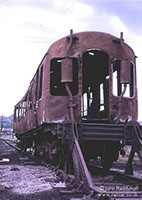DMU Accident
Bescar Lane, LMR - 09/05/71
A Class 110 set working the 11:35 Southport - Wigan was carrying between 30 and 40 passengers on the above date. It was travelling about 50mph soon after leaving Meols Cop when the driver's attention was drawn to smoke in the leading power car. He brought the train to a standstill and the passengers were detrained, no-one being injured. The train crew attempted to tackle the fire with extinguishers but both driver and guard were unable to trigger the action of the pistol-type extinguishers. The fire soon got a good hold and the leading car was completely gutted and the leading end of the adjacent trailer car sustained similar damage, lessening towards the rear of the vehicle.
The investigation that followed (the investigation was led by Lt Col IKA McNaughton) was unable to point specifically to the chain of events which led to the fire, but was satisfied that the source of the fire was a short-circuit in an electrical connection.
Since built ten years previously, the class had suffered a higher rate of fires than any other type. Most were caused by exhaust system faults, but several involved the heater ducting. A number of modifications had been carried out in an attempt to reduce the fire risk, particularly in the area around the exhaust system and heater ducting, where an overspill of diesel fuel from the main filler pipe could saturate lagging around the ducting. Glass reinforced plastic (GRP) material was used for part of the ducting, although the ducting in the immediate area of the heater itself was of mild steel. In the unit involved in the fire, the junction between cross-ducting and longitudinal ducting on the right-hand side of the car was immediately below the exterior door and above longitudinal steel cable trunking carrying the main electrical circuits of the vehicle. It was also close to the main fuel filler pipe.
Tests carried out at the Railway Technical Centre at Derby showed that the GRP material was highly flammable, the specimens continuing to burn after removal of the flame. In a full scale mock-up of a representative section of lagged and wrapped GRP ducting, with a section of floor placed over it, it was found that with lagging soaked in fuel oil fire spread to the inside of the ducting after 3 mins and burned for over 20 mins. The latex foam used for filling seats could be ignited with a match without difficulty and thereafter burned vigorously. Lt. Col McNaughton thought it unlikely that the spread of fire into the car interior occurred as a result of penetrating the floor in the area over the original seat of the fire and probably occurred after the exterior of the car was well alight as a result of flames entering the heater system. He concluded that the fire started when a 24v arc was set up between the copper core of the positive cable from a battery charging socket and a metal bush at the point where the conduit to the socket joined the cable trunking. The insulation of the cable had chafed through over a period of time as shown by verdigris on the exposed copper.
The Inspecting Officer also remarked that previous modifications in an attempt to reduce the fire risk had not been altogether successful and said that the existence of an established fire route through the heater duct into the passenger accommodation was an unacceptable hazard which should be eliminated as a matter of urgency. The flammable GRP ducting was to be replaced by mild steel, and a non-absorbent type of lagging was to be fitted as quickly as possible. Latex foam seat filling was now not to be used either for new vehicles or replacement seats and would progressively be eliminated.
Lt Col McNaughton said the train crew acted correctly and even though they could not make the extinguishers work there was little chance of them making any effect on the fire once it had a hold. It seemed likely that the fire extinguishers may not have been operated correctly by the crew and in some circumstances would lock. Practical demonstrations of handling extinguishers were now included in the basic training of all new entrants, and existing guards and drivers would receive similar training as soon as possible.

This DMBC pictured at Hammerton Street on 21/5/72 is thought to be 52074 and/or involved in the fire described. The other centre car involved is believed to have been 59705, both being withdrawn in June 1971 and cut up in Hammerton Street in July 1972. John Reddyhoff.


